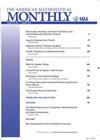An Observation on Average Velocity
IF 0.4
4区 数学
Q4 MATHEMATICS
引用次数: 0
Abstract
Suppose that a particle moves with position s(t) and velocity v(t) for t ∈ [0, T ]. If s(t) is continuous on [0, T ] and differentiable on (0, T ), then the mean value theorem, which is in (almost) all calculus texts, asserts that there is some point in (0, T ) at which the particle’s velocity is equal to its average velocity on [0, T ]. But it is natural to ask whether there is some subinterval of length 1 on which its average velocity is equal to its average velocity on [0, T ]. The answer to this question, which is in (almost) no calculus texts, is as follows:关于平均速度的观测
假设一个粒子以位置s(t)和速度v(t)移动,对于t∈[0,t]。如果s(t)在[0,t]上是连续的,在(0,t)上是可微的,那么(几乎)所有微积分文本中的中值定理断言,在(O,t)中有一个点,粒子的速度等于其在[0、t]上的平均速度。但很自然地会问,是否存在长度为1的某个子区间,其平均速度等于[0,T]上的平均速度。这个问题(几乎)没有微积分文本,答案如下:
本文章由计算机程序翻译,如有差异,请以英文原文为准。
求助全文
约1分钟内获得全文
求助全文
来源期刊

American Mathematical Monthly
Mathematics-General Mathematics
CiteScore
0.80
自引率
20.00%
发文量
127
审稿时长
6-12 weeks
期刊介绍:
The Monthly''s readers expect a high standard of exposition; they look for articles that inform, stimulate, challenge, enlighten, and even entertain. Monthly articles are meant to be read, enjoyed, and discussed, rather than just archived. Articles may be expositions of old or new results, historical or biographical essays, speculations or definitive treatments, broad developments, or explorations of a single application. Novelty and generality are far less important than clarity of exposition and broad appeal. Appropriate figures, diagrams, and photographs are encouraged.
Notes are short, sharply focused, and possibly informal. They are often gems that provide a new proof of an old theorem, a novel presentation of a familiar theme, or a lively discussion of a single issue.
Abstracts for articles or notes should entice the prospective reader into exploring the subject of the paper and should make it clear to the reader why this paper is interesting and important. The abstract should highlight the concepts of the paper rather than summarize the mechanics. The abstract is the first impression of the paper, not a technical summary of the paper. Excessive use of notation is discouraged as it can limit the interest of the broad readership of the MAA, and can limit search-ability of the article.
 求助内容:
求助内容: 应助结果提醒方式:
应助结果提醒方式:


